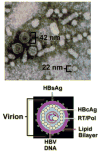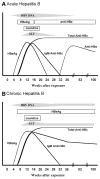Hepatitis B: the virus and disease
- PMID: 19399811
- PMCID: PMC2809016
- DOI: 10.1002/hep.22881
Hepatitis B: the virus and disease
Abstract
Hepatitis B virus (HBV) infects more than 300 million people worldwide and is a common cause of liver disease and liver cancer. HBV, a member of the Hepadnaviridae family, is a small DNA virus with unusual features similar to retroviruses. HBV replicates through an RNA intermediate and can integrate into the host genome. The unique features of the HBV replication cycle confer a distinct ability of the virus to persist in infected cells. Virological and serological assays have been developed for diagnosis of various forms of HBV-associated disease and for treatment of chronic hepatitis B infection. HBV infection leads to a wide spectrum of liver disease ranging from acute (including fulminant hepatic failure) to chronic hepatitis, cirrhosis, and hepatocellular carcinoma. Acute HBV infection can be either asymptomatic or present with symptomatic acute hepatitis. Most adults infected with the virus recover, but 5%-10% are unable to clear the virus and become chronically infected. Many chronically infected persons have mild liver disease with little or no long-term morbidity or mortality. Other individuals with chronic HBV infection develop active disease, which can progress to cirrhosis and liver cancer. These patients require careful monitoring and warrant therapeutic intervention. Extrahepatic manifestations of HBV infection are rare but can be difficult to diagnose and manage. The challenges in the area of HBV-associated disease are the lack of knowledge in predicting outcome and progression of HBV infection and an unmet need to understand the molecular, cellular, immunological, and genetic basis of various disease manifestations associated with HBV infection.
Conflict of interest statement
Potential conflict of interest: Nothing to report.
Figures





Similar articles
-
Chronic hepatitis B virus infection in Asian countries.J Gastroenterol Hepatol. 2000 Dec;15(12):1356-61. doi: 10.1046/j.1440-1746.2000.0150121356.x. J Gastroenterol Hepatol. 2000. PMID: 11197043 Review.
-
Hepatitis B virus: from diagnosis to treatment.Pathol Biol (Paris). 2010 Aug;58(4):245-53. doi: 10.1016/j.patbio.2010.05.002. Epub 2010 Jul 1. Pathol Biol (Paris). 2010. PMID: 20580167 Review.
-
China's efforts to shed its title of "Leader in liver disease".Drug Discov Ther. 2007 Oct;1(2):84-5. Drug Discov Ther. 2007. PMID: 22504391
-
Natural history of chronic hepatitis B virus infection in adults with emphasis on the occurrence of cirrhosis and hepatocellular carcinoma.J Gastroenterol Hepatol. 2000 May;15 Suppl:E25-30. doi: 10.1046/j.1440-1746.2000.02097.x. J Gastroenterol Hepatol. 2000. PMID: 10921378
-
Profile, spectrum and significance of hepatitis B virus genotypes in chronic HBV-infected patients in Yunnan, China.Hepatobiliary Pancreat Dis Int. 2008 Jun;7(3):271-9. Hepatobiliary Pancreat Dis Int. 2008. PMID: 18522881
Cited by
-
Altered expression of A20 gene in peripheral blood mononuclear cells is associated with the progression of chronic hepatitis B virus infection.Oncotarget. 2016 Oct 18;7(42):68821-68832. doi: 10.18632/oncotarget.11993. Oncotarget. 2016. PMID: 27634895 Free PMC article.
-
Prevalence and characterization of occult hepatitis B infection among blood donors in central Saudi Arabia.Saudi Med J. 2016 Oct;37(10):1114-9. doi: 10.15537/smj.2016.10.14708. Saudi Med J. 2016. PMID: 27652363 Free PMC article.
-
Awareness of Hepatitis B Virus (HBV) Screening Before Marriage and Pregnancy Among Adults in the Al-Baha Region, Saudi Arabia.Cureus. 2024 Jan 10;16(1):e52057. doi: 10.7759/cureus.52057. eCollection 2024 Jan. Cureus. 2024. PMID: 38213938 Free PMC article.
-
Antiviral Activity of Interferon Alpha-Inducible Protein 27 Against Hepatitis B Virus Gene Expression and Replication.Front Microbiol. 2021 Mar 31;12:656353. doi: 10.3389/fmicb.2021.656353. eCollection 2021. Front Microbiol. 2021. PMID: 33868214 Free PMC article.
-
Serologic and genotypic characterization of hepatitis B virus in HIV-1 infected patients from South West and Littoral Regions of Cameroon.Virol J. 2016 Oct 21;13(1):178. doi: 10.1186/s12985-016-0636-x. Virol J. 2016. PMID: 27769271 Free PMC article.
References
-
- Ganem D, Schneider RJ. Hepadnaviridae and their replication. In: Knipe DM, Howley PM, Griffin DE, Martin MA, Lamb RA, Roizman B, et al., editors. Fields Virology. 4. Philadelphia, PA: Lippincott-Raven Publishers; 2001.
-
- Hollinger FB, Liang TJ. Hepatitis B virus. In: Knipe DM, Howley PM, Griffin DE, Lamb RA, Martin MA, Roizman B, et al., editors. Fields Virology. 4. Philadelphia, PA: Lippincott-Raven Publishers; 2001. pp. 2971–3036.
-
- Gavilanes F, Gonzales-Ros A, Peterson D. Structure of hepatitis B surface antigen: characterization of the lipid components and their association with the viral proteins. J Biol Chem. 1982;257:7770–7777. - PubMed
-
- Gerlich W, Robinson WS. Hepatitis B virus contains protein attached to the 5′ end of its complete strand. Cell. 1980;21:801–811. - PubMed
Publication types
MeSH terms
Grants and funding
LinkOut - more resources
Full Text Sources
Other Literature Sources
Medical
